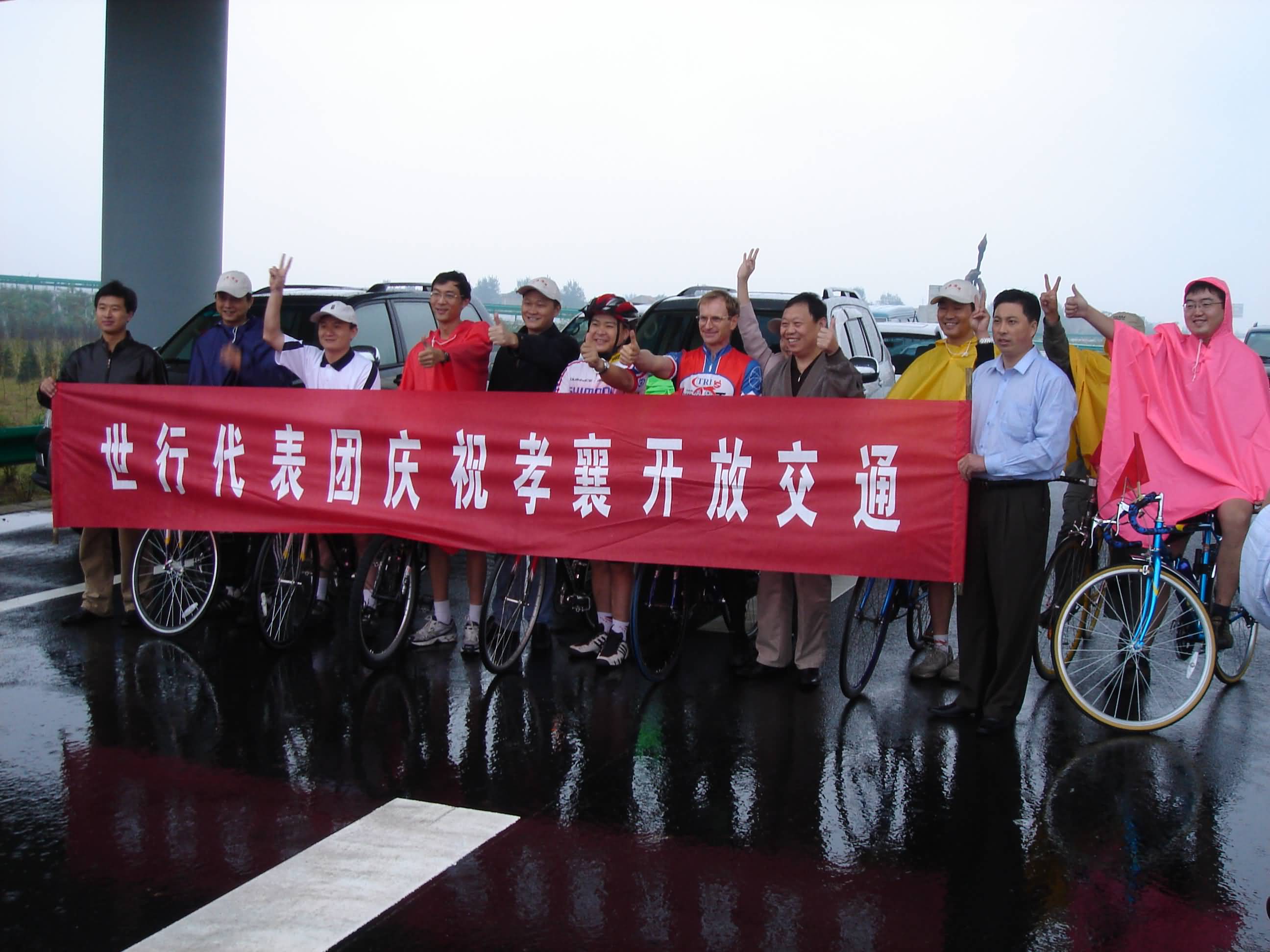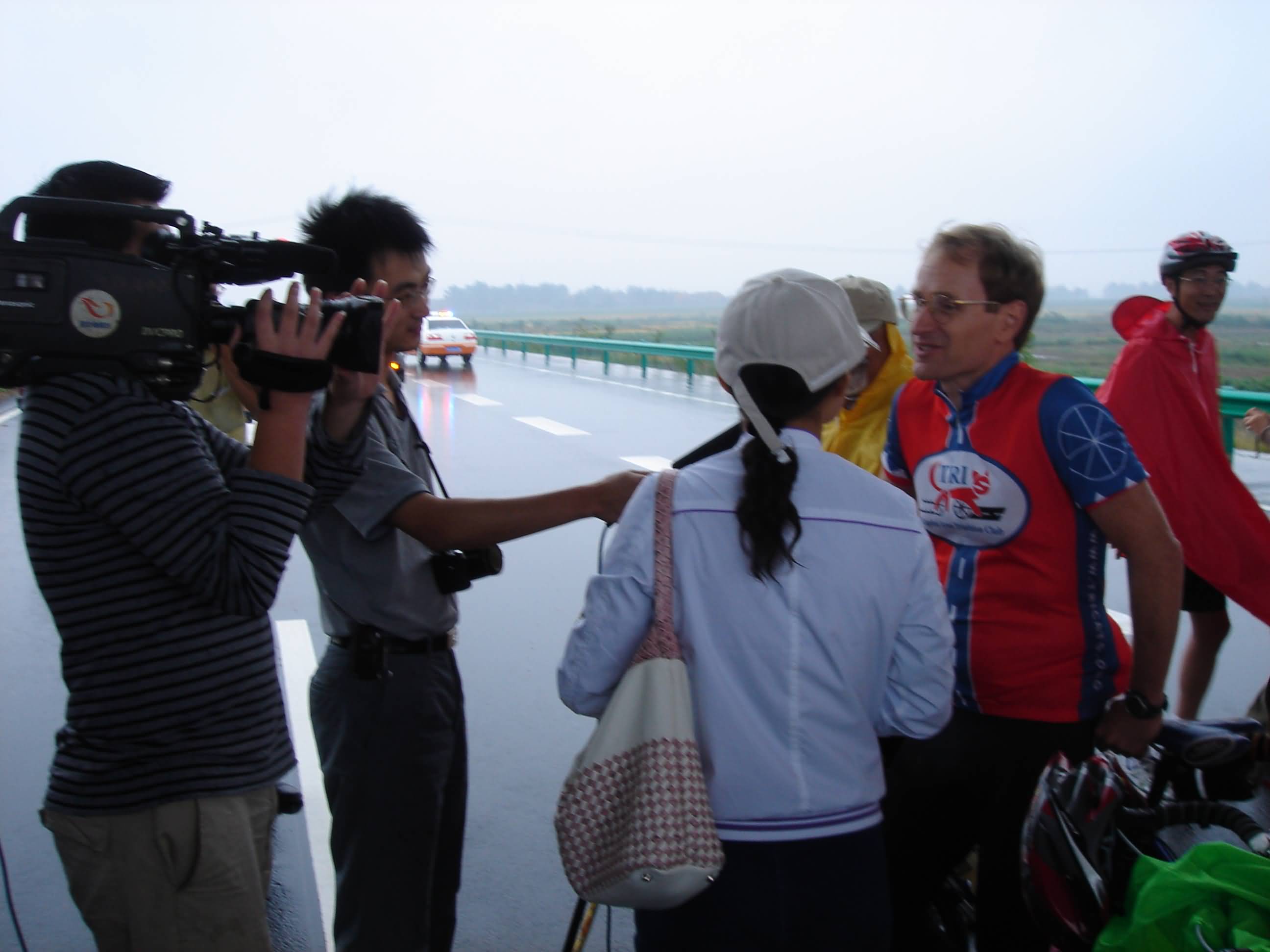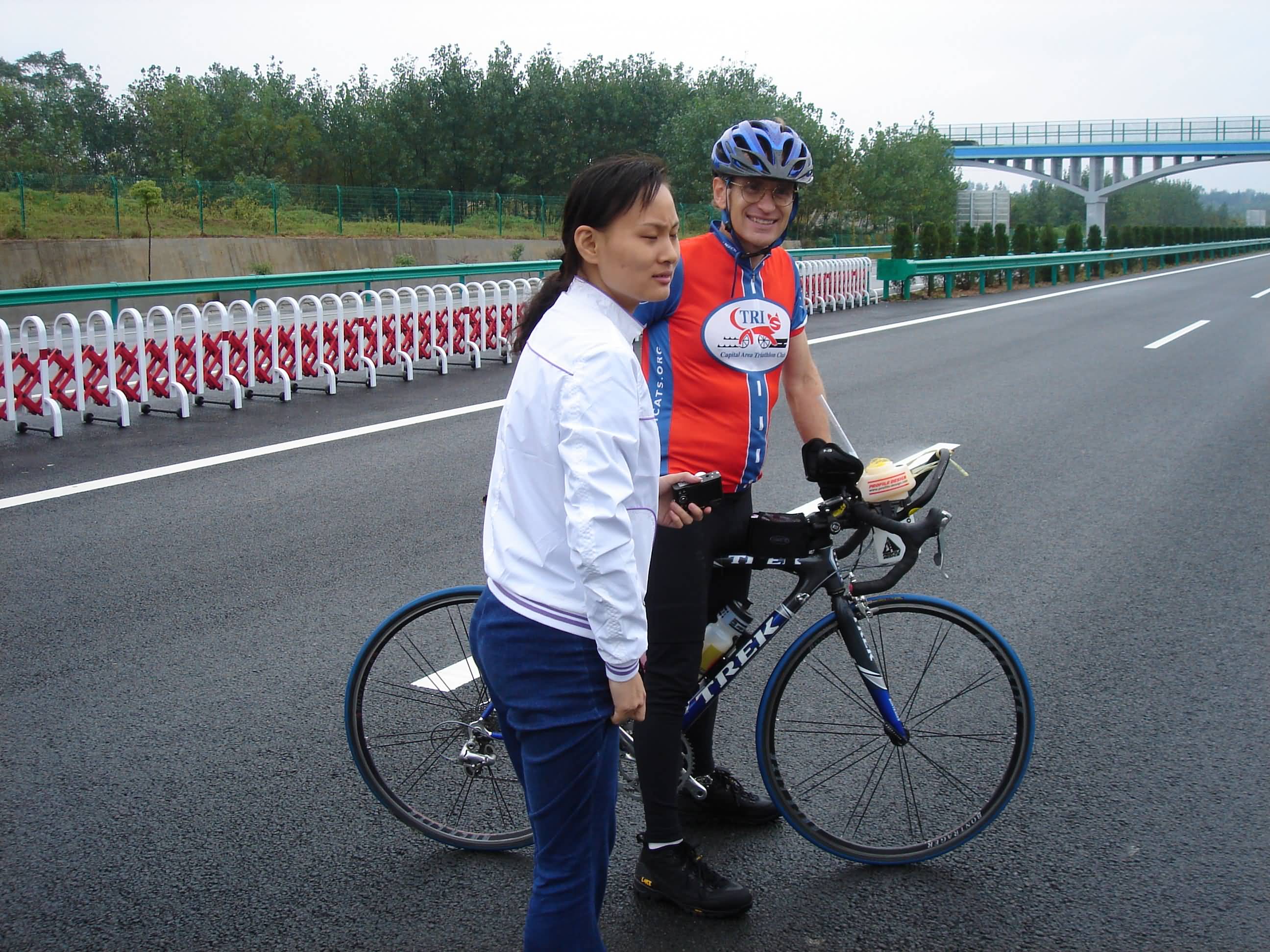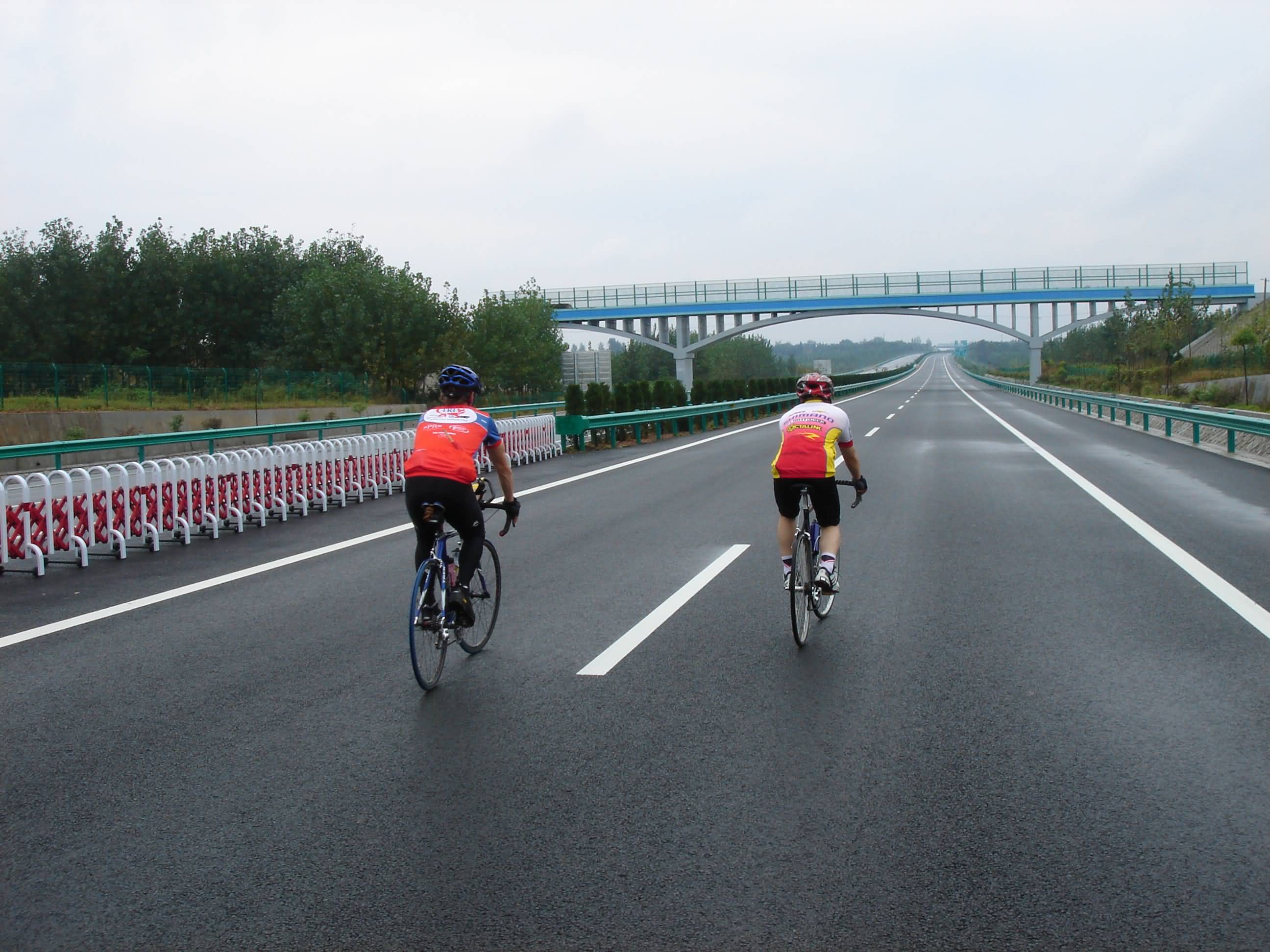
Cycling the Xiaoxiang Expressway
Hubei, China
| 2006 Update: The World Bank ran a story on this ride on their intranet. You can read the story as well as look at a video created by Hubei Television of the event here. |
If you ask a cyclist what are the downsides to cycling, the answer would usually be along the lines of (i) traffic; (ii) hills; (iii) headwinds; and, (iv) rain. Perhaps not in that order, but some, if not all, would be there. For me it is traffic. There is nothing worse than having to dodge cars that pull out in front of you, honk their horns from behind, or that come so close that you clean the dirt off their passenger side mirror. I've liked them even less ever since I got knocked off my bike during my trans-american trip and had my collar bone broken by somebody opening their door at an inopportune moment. But that's another story.
China is famous for being a country of cyclists, but that is fading quickly as the country modernizes and motorizes. In fact, some cities such as Shanghai have now banned bicycles from the central area since they interfere with cars. However, most Chinese are still interested in bicycling and when I began to work in China they were amazed that I had done trips of several thousand kilometres at time by bicycle. Mr. Wang Yanghong from the Hubei Provincial Communications Department (HPCD) joked one day that I should use my bike to do an inspection of one of the highways I am supervising on the World Bank's behalf. Thus was born the idea of cycling the Xiaogan - Xiangfan (Xiaoxiang) Expressway.
Some background ... The government of China has embarked on developing a National Trunk Highway System (NTHS) which consists of building expressways to link all the major cities with each other, and especially ports. The NTHS will result in a network equivalent to, or larger than, the US Interstate Highway System (about 70,000 km) and enhance China's economic and social development. Construction is happening at a rapid rate; in just over 10 years they have gone from almost no expressways to over 32,000 km. The World Bank is financing a small portion of the network and one of these was the Xiaoxiang Expressway in Hubei Province.
Mr. Wang and I decided that to celebrate the opening of Xiaoxiang I would ride my bicycle for the length of the expressway, and he would accompany me. The idea of having an empty expressway to myself on a bicycle was impossible to refuse and, when we told others, they were also smitten with the idea. In the end, we had seven cyclists comprised of one foreigner; two from the World Bank's Beijing office (Zhefu and Nathan), three from the Hubei Provincial Communications Department (HPCD) and one from the Provincial Development and Reform Commission (PDRC). We were also joined for the first two kilometres by my environmental consultant Anil Somani who succumbed to the enthusiasm and mounted my spare bicycle.

The Chinese are consummate organizers and the HPCD did an amazing job. They arranged for the police to provide an escort to ensure our safety since, even though the road was still closed, there was still a little construction traffic and the occasional dignitary zooming through. There were several 'sag wagons': vehicles which would hold a bike if the cyclist got tired and which also had food and other important supplies. There were small flags that were attached to our bicycles, celebrating the "rally". There was even a doctor for accidents (and massage). Lastly, there was a TV crew from the Hubei provincial television station. They asked me a few questions before the ride, and then popped up a regular intervals to record our progress. Apparently cycling a closed expressway was a newsworthy event, especially as it involved a foreign World Bank advisor!

One thing that the HPCD could not control was the weather, and it was horrible. A tropical storm was hitting the south of China and we had the dregs of it. Lots of rain and strong headwinds. I was the only one who had ever cycled that distance before and so I knew how hard it was going to be to battle through such weather, but the arrangements had been made and the show had to go on! In hindsight it proved to be a good decision since the following day was wetter, windier, and colder. Rain isn't the problem; it is the cold that usually accompanies it. One gets chilled to the bone and hour after hour ones strength and enthusiasm is sapped.
Fortunately, the morning of the ride, Mr. Wang got the idea of going over to the railway station where he purchased some plastic ponchos and paper clips. The latter were used to hold them on the handle bars. I was skeptical that they would make much of a difference but they worked surprisingly well. The legs and feet got wet, especially from the spray kicked up from the wheels, but they were a good windbreak which kept the cold at bay. I just wished the back flap was a little longer so I could have sat on it. I was initially handed a pink one but I swapped with Mr. Zhou. The color clashed too much with my black tights (and thus my vanity).
I had expected to start at the beginning of the road but for some unknown reason we started at a toll station about 20 km from the beginning. That left us 221 km to cycle so it was going to be a long day. After the TV interview was over, gear checked, raingear on, photos taken, with a cheer we were off and riding!
When it came to preparation, I definitely had the advantage. I had competed in 4 triathlons (including a half ironman) over the previous 12 weeks, and I even brought my carbon-fiber Trek road racing bike. I had a nutrition plan with appropriate drinks and gels to fuel me along the way. Contrast this with Nathan who had not cycled since he was in school (quite a few years ago I suspect), and bought a $US 80 bike a few days before the ride. My aero bars cost more than that!
Several others had also bought bikes in the preceding days and had not even adjusted the seat height to the proper level. When I realized this some kilometres into the ride, I raised Yuwe and Nathan's seats, which they said made the world of difference. No kidding. These 6 foot tall guys were riding at a height suitable for a midget. Mr. Wang had bought a very nice Giant road bike and he used it to good effect; he was the second fastest after me and we regularly outpaced the others. Not bad for a couple of guys on the wrong side of 40 years old.

The rain was with us for most of the day. There were a few times when it stopped, or was just a light mist, but for too many hours it was a heavy downpour as you can see from the photo below. While it dampened our clothes, it didn't affect our enthusiasm and we all enjoyed the ride, forming natural groups and chatting as we travelled along. Mr. Wang and I were the fastest so we kept together, but it was not a race so we had frequent stops to let the others catch up or to have food. The bridges provided a good shelter from the rain, except when it was being driven almost horizontally.
Zhefu from the Bank's Beijing office was one tough fellow. He removed his poncho at the first opportunity and did much of the trip in shorts and a t-shirt. This was while I was under my poncho, with arm and leg warmers, and still feeling the chill. I console myself with the thought that even though I was raised in Canada, I have discovered that I am more suited to tropical climates. Give me the heat any day over the cold.
One advantage to the rain was that it gave me the opportunity to check on the road's drainage. After all, this was an inspection tour! I have decided that there is no better way to inspect a highway as I was able to travel all over the road, view the drains, safety features, and other aspects of the highway. When I found a few minor issues I asked my highway engineer Jean-Marie Braun (who was not so crazy as to cycle) to look at them when we caught up at rest stops. While there were minor defects, the quality of road could not be faulted and we had a smooth, ideal pavement for our trip. What cyclist doesn't dream of cycling in a situation like the photo below shows?

As the miles built up a few riders dropped out. After 90 km we stopped for a late lunch of noodles at a toll station and there were still five of us on the road. Our speed was much lower than it needed to be in order for us to finish before dark, but given the weather conditions and the general lack of cycling fitness (nobody had every done more than 40 km before!) everyone had done very well. The noodles were an excellent pick me up (give me heat!) and we all felt re-invigorated.
It was decided that we would go at our own speeds after lunch. I wanted to make Xiaogan at a sensible hour so I put the hammer down and rode the last 130 km in just over 4 h with an average speed of 30 km/h. I had my own police car and a sag vehicle following, but otherwise I was on my own, cycling through the beautiful quiet autumn countryside of China, with an empty road ahead of me. Even the weather got better for a while. Bliss.
The expressway started off in plains but as the ride progressed we entered into some rolling country. That gave me the opportunity to stand up out of the peddles and have a good stretch as I attacked the hills with enthusiasm. I have been very fortunate this year to go out on a weekly training ride with a club in Washington which is 50-60 km of hills. I find that I don't mind them as much now, and it is a actually a nice change. Especially going down the other side. I need to say, though, that a properly designed expressway like this does not have gradients above 4% so the hills, while often long, are not difficult.
I find that on long rides like this I 'zone out' insofar as my body is working hard at its natural rhythm, my breathing rate is steady and it is actually somewhat relaxing. I feel that I can go on forever and it takes an effort to interrupt things to eat or drink something. What was especially nice was that as the evening approached the rain shifted to a light, cooling mist. Life is good.
The camera crew kept on reappearing and pointing their camera at me out the window, out the sun roof, stopping ahead and getting an action shot etc. It soon lost its novelty and was a bit of a distraction. Made me feel very sorry for Lance Armstrong and the close attention he gets!
As darkness fell I was illuminated from behind by the police car and the support vehicle. It was even more hypnotic watching the shadows of my legs moving up and down in their rhythm. I found it especially nice to know that I didn't need to worry about the usual traps for cyclists at night (like sewer gratings the wrong way, potholes, patches, etc.) and could just concentrate on my cycling and the dark surroundings. Some of the other support vehicles drove by and told me where the others were, and one snapped the photo action below.
Over the course of the ride I passed quite a few peasant farmers who were walking on the road, or just next to it. They looked a bit stunned to see a foreigner on his bike accompanied by a police car but never said anything. Near Xiaogan I passed a crew working on sound barriers who cheered me on and gave me a thumbs up, which I gladly returned. China is different to India insofar as in India almost every person I passed would have done that, or at least commented 'farenghi'.
All good things come to an end but the problem was that I didn't know where the end would be! While the expressway was 244 km long, we didn't start at the beginning and the kilometre markers were placed relative to Wuhan. This meant that I could only guess where that was. I guessed wrong and it was a further half-hour of riding in the dark before I reached the barrier marking the Xiaogan interchange and the end of the ride. This is a stunning interchange with a huge single column cable stayed bridge. Very impressive engineering and I could see the structure illuminated by the headlights of the traffic against the black sky.
I was congratulated by the TV crew and answered some more questions, before hopping on my bike and doing another kilometre so that I was in the middle of the interchange. Job done but I didn't feel like stopping. Seriously. My backside and knee was sore, but I felt full of energy and just wanted to go on. Fortunately, my brain kicked in so I chucked my bike in the car to go and find the others.
The key statistics: It took 8.5 h of riding to do 222 km for an average speed of 26 km/h (21.5 km/h for the first 90 km; 30 km/h for the last 132 km). There was about 1.5 h of stops.
And the others? I told the TV crew that the real heroes of the day were still out there. Zhefu and Nathan continued cycling and finished about 3 h behind me. So all three World Bankers finished the entire length. Given that Nathan hadn't ridden for years, and bought a cheap bike 2 days before the ride, it was incredible. Zhefu, who rides to the office in Beijing every day, only slightly less so. Mr. Wang did over 200 km at 20+ km/h, before calling it a day. Quite the feat given he had never ridden more than 40 km before. Mr. Zhou toughed it out for about 150 km with a seat that was too low (I told him!). Like Nathan, he doesn't ride and bought his bike for the race.
So hats off to my Chinese colleagues who showed me what real courage is like on a bike. I look forward to having the opportunity to do this again someday. We have the Shiman expressway opening in about three years. That is only about 100 km, but it is about 40 per cent tunnels and bridges through mountains so it will be more of a challenge. However, given this years performance, I expect that they will do it with ease, even both ways.
loans loans loans loans loans loans loans loans loans loans loans loans loans loans loans loans loans loans loans loans loans loans loans loans loans loans loans loans loans loans loans loans loansloans loans loans loans loans loans loans insurance insurance mortgage mortgage